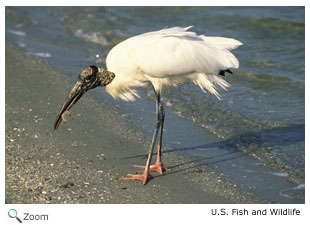Ciconiidae - storks
 Storks have long legs, long bills, long wings, and long necks. They usually have bare heads and necks. Storks are found in all parts of the world where it is warm. Most stork species are migratory. Storks have long legs, long bills, long wings, and long necks. They usually have bare heads and necks. Storks are found in all parts of the world where it is warm. Most stork species are migratory.
Storks don't have a pharynx so they don't have any vocalizations! They clack their bills to communicate!
Storks are wading birds and eat fish, small mammals, amphibians, birds, and insects. Storks usually use the same nesting site from year-to-year, and stork mating pairs will add on to their nest. Stork nests can become as large as six feet in diameter and 10 feet deep.
The wood stork is the only member of this family that breeds in the United States. Small and endangered breeding populations can be found in Florida, Georgia, South Carolina, and North Carolina. The wood stork is also found throughout much of South America, Central America, and the Caribbean, where it is not endangered.
The wood stork stands around 2.5-3.5 feet tall. It has a white body and a featherless black head and neck. It has a long, down-curved yellow bill and long black legs with pinkish feet. It is found in marshes and swamps and walks though shallow water searching for prey like small fish, frogs, and large insects. It locates prey by opening its bill in the water and waiting for prey to run into it! When is feels something touch its bill, it quickly snaps it shut. The wood sotrk was once know as the wood ibis.
The jabiru is a stork found in Central and South America. It is the tallest flying bird found in the Americas. It can be up to five feet tall and can have a wingspan 7-9 feet. It has a white body and a featherless black head and upper neck and a featherless red pouch at the base of its neck.
There are 19 species in this family.
World Status Key
 Least Concern Least Concern  Near Threatened Near Threatened  Vulnerable Vulnerable  Endangered Endangered  Critically Endangered Critically Endangered  Extinct in the Wild Extinct in the Wild  Extinct Extinct
Status and range is taken from ICUN Redlist. If no status is listed, there is not enough data to establish status.
US Status Key
 Threatened in US Threatened in US  Threatened in NH Threatened in NH  Endangered in US Endangered in US  Endangered in NH Endangered in NH  Breeds in NH Breeds in NH  Introduced Introduced
Status taken from US Fish and Wildlife and NH Fish and Game
Additional Information
Key:  Profile Profile  Photos Photos  Video Video  Audio Audio
Storks  
Storks are found on all continents except Antarctica and are most common in tropical regions.
Source: San Diego Zoo Intended Audience: Students Reading Level: Middle School
Abdim's Stork - Ciconia abdimii     
Abdim's stork migrates with the rainfall.
Source: Arkive Intended Audience: General Reading Level: Middle School
Asian Openbill - Anastomus oscitans   
The Asian openbill is found in Bangladesh, Cambodia, India, Laos, Myanmar, Nepal, Pakistan, Sri Lanka, Thailand, and Vietnam.
Source: Arkive Intended Audience: General Reading Level: Middle School
Black Stork - Ciconia nigra      
The black stork is found from Spain to China during the nesting season.
Source: Animal Diversity Web Intended Audience: General Reading Level: Middle School
Black Stork - Ciconia nigra       
The black stork has a black head, upperparts, wings, tail and neck and a white belly and undertail.
Source: Arkive Intended Audience: General Reading Level: Middle School
Black-necked Stork - Ephippiorhynchus asiaticus      
The black-necked stork is found in Australia, Bhutan, Cambodia, India, Indonesia, Laos, Myanmar, Nepal, Papua New Guinea, and Sri Lanka.
Source: Animal Diversity Web Intended Audience: General Reading Level: Middle School
Greater Adjutant - Leptoptilos dubius     
The greater adjutant is found in Bangladesh, Cambodia, India, Nepal, Thailand, and Vietnam.
Source: Arkive Intended Audience: General Reading Level: Middle School
Jabiru - Jabiru mycteria     
The jabiru is found from Mexico to Argentina. It occasionally is seen in Texas.
Source: Animal Diversity Web Intended Audience: General Reading Level: Middle School
Jabiru - Jabiru mycteria    
Jabirus are found in large groups near rivers and ponds.
Source: Arkive Intended Audience: General Reading Level: Middle School
Lesser Adjutant - Leptoptilos javanicus    
The lesser adjutant is found in Bangladesh, Brunei Darussalam, Cambodia, India, Indonesia, Laos, Malaysia, Myanmar, Nepal, Sri Lanka, Thailand, and Vietnam.
Source: Arkive Intended Audience: General Reading Level: Middle School
Marabou Stork - Leptoptilos crumeniferus    
The Marabou stork is found in Sub-Saharan Africa.
Source: Arkive Intended Audience: General Reading Level: Middle School
Marabou Stork - Leptoptilos crumeniferus    
The Marabou stork is one of the largest flying birds in the world.
Source: National Zoo Intended Audience: Students Reading Level: Middle School Milky Stork - Mycteria cinerea    
The milky stork is found in Cambodia, Indonesia, and Malaysia.
Source: Arkive Intended Audience: General Reading Level: Middle School
Oriental Stork - Ciconia boyciana    
The Oriental stork is found in China, Hong Kong, Japan, North Korea, South Korea, and Taiwan.
Source: Arkive Intended Audience: General Reading Level: Middle School
Painted Stork - Mycteria leucocephala    
The painted stork gets its name from its pink tertial feathers.
Source: Arkive Intended Audience: General Reading Level: Middle School
Saddle-billed Stork - Ephippiorhynchus senegalensis    
The saddle-billed stork has a bright red bill with large black band.
Source: Arkive Intended Audience: General Reading Level: Middle School
Storm's Stork - Ciconia stormi     
The Storm's stork is found in Brunei Darussalam, Indonesia, Malaysia, and Thailand.
Source: Arkive Intended Audience: General Reading Level: Middle School White Stork - Ciconia ciconia       
The white stork breeds grounds southern Europe, the Middle East and west-central Asia. It winters in southern Africa.
Source: Arkive Intended Audience: General Reading Level: Middle School Wood Stork - Mycteria americana    
The wood stork is the only stork that breeds in the United States.
Source: Arkive Intended Audience: General Reading Level: Middle School
Wood Stork - Mycteria americana      
The wood stork has a bald black head and neck and a white body.
Source: Cornell Lab of Ornithology Intended Audience: General Reading Level: Middle School
Wood Stork - Mycteria americana      
The wood stork places its open bill in the water; when it feels a fish touch its bill, it snaps it closed.
Source: National Geographic Intended Audience: General Reading Level: Middle School
Woolly-necked Stork - Ciconia episcopus     
The wooly-necked stork is usually non-migratory.
Source: Arkive Intended Audience: General Reading Level: Middle School
Yellow-billed Stork - Mycteria ibis    
The yellow-billed stork has a long, conical bill and a red face mask.
Source: Arkive Intended Audience: General Reading Level: Middle School
|

